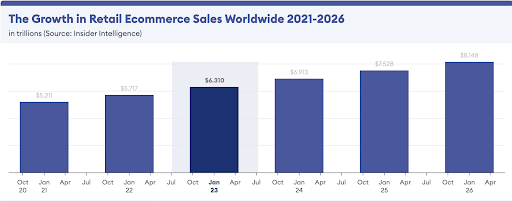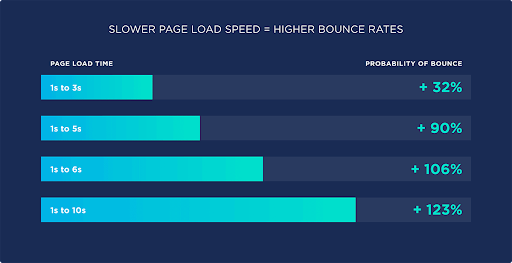Politics
Page Speed and SEO: How to Improve E-Commerce Websites
Published
11 months agoon
By
Drew Simpson
The e-commerce industry has seen double-digit growth every year for the past decade. Expanding by 31% in just the last two years, worldwide e-commerce sales are now tipped to hit $8 trillion by 2026.
(Image Source: Forbes Business)
On the back of a post-pandemic commerce boom and a global turn to smartphone-centric shopping, the competition to score leads online has never been harder.
Consumers are more demanding, and with more industry competitors to battle against, your site has to be in tip-top shape. Your site SEO strategy plays a crucial role in your online success in 2023. If you want to improve your search engine visibility and be in with a chance of scoring conversions, all aspects of your store should be optimized for a seamless user experience.
Stick with us as we address everything from page speed to personalization in the battle to become an e-commerce industry leader.
Addressing E-commerce Competition in 2023
It’s no secret that e-commerce competition is on the rise. As the high street dwindles, we find more innovative ways to access omnichannel shopping online. Whether you tap into e-commerce through the world wide web or jump into the TikTok shop on your lunch break, digital evolution is making it easier than ever before to purchase a product/service online.
The question is, how can small business owners keep up? As industry giants like Amazon and ASOS dominate the field, it’s up to smaller industry players to match their levels of personalization and gratification and prioritize a consumer-led approach to e-commerce.
“If you’re competitor-focused, you have to wait until there is a competitor doing something. Being customer-focused allows you to be more pioneering,” says Jeff Bezos, Founder of Amazon. “We see our customers as invited guests to a party, and we are the hosts. It’s our job every day to make every important aspect of the customer experience a little bit better.”
In fact, a whopping 91% of consumers now claim that they are more likely to shop with a brand that prioritizes their personal preferences and offers a seamless experience.
Offering your target audience an effortless journey from first impression to checkout is key in 2023. With so many options at a consumer’s fingertips, it’s up to your site to provide them with an experience they can’t receive anywhere else. This means that all areas of your site must be optimized to account for customization, inclusive accessibility, and a speedy journey to conversion.
Why is Site Speed so Important?
The e-commerce industry has become an arena for instant gratification, rendering site speed a top priority for modern online shoppers.
In fact, fast-loading pages are significantly linked to e-commerce success. Not only do speedy sites encourage visitors to stay on the site for longer, but just a one-second site speed improvement could boost your conversion rate by 27%.
The question is, how does site speed affect your SEO? According to Google, page loading time is one of the key ranking factors a search engine’s algorithm takes into account when scoring site domains.
Google is constantly looking to offer its users the best possible experience. So if your page loading speed is slow, you’ll find yourself further down the search string.
Slow page loading speed also encourages a higher bounce rate. Consumers are looking for quick calls to action and an effortless path to the checkout.

(Image Source: Backlinko)
With so many industry competitors to choose from, you could lose up to 100% of your traffic if your page takes just 6 seconds to load.
“Think about your own browsing habits. If you would not wait around for a page to load, why would you expect your customers to do so? They would not either,” says Chuck Kim, Co-founder of Executive Digital. “That’s why it’s vital to understand that every customer who bounces from your site is potentially a lost sale.”
3 Ways to Keep Your On-Page SEO In Check
If you want your e-commerce site to perform well in a competitive environment, you need to regularly review your SEO practices. Not only does an SEO-optimised website provide a more seamless experience for a consumer. But it’s much more likely to be picked up by Google’s algorithm in an engine search.
Here are three ways to keep your on-page SEO in check for a faster-loading website and an e-commerce experience your consumers will come back to.
Removing Traffic Bots
In a global e-commerce landscape, online stores now find themselves flooded with traffic from a range of sources. With the ability to tap into Google from any country on any device or domain, there’s significant room for ‘botnet’ style traffic.
Not only can this clog up your server. If your site has small bandwidth, traffic bots can slow loading times down and even impact analytics metrics. This includes session duration, page views, and the geolocation of users.
Using analytic tools such as Finteza, you can swiftly detect and remove bot traffic, creating a site that runs more efficiently. As a multi-stage audience quality evaluation tool that is enabled to prioritize UTM tracking, Finteza can detect up to 12 types of dangerous or low-quality traffic sources.

Working as a webmaster’s analytic partner, Finteza produces reports in real-time. With the ability to monitor your traffic sources 24/7, the system can automatically notify you of suspicious threats and compile page-specific charts and graphs of live data.
Tracking
Better still, Finteza can even track the full path of a potential ‘bot’, making it easier to map suspicious activity. Using their Funnels feature, you can follow a bot’s journey from its source all the way to the checkout, aiding you in detecting potential fake conversions.
If you’re aiming to improve your page loading speed, removing bot traffic is essential. Not only will this help put an end to click fraud sessions, but with an accurate breakdown of your organic traffic, you’ll quickly be able to spot areas for UX improvement based on audience behavior stats.
In order to optimize your on-page SEO, it’s important to delve into organic traffic data. The more accurate your analytics are, the better your decision-making will be. Gaining knowledge about your audience’s behavior is key to improving bounce rates. Additionally, it ensures that the journey from impression to checkout is smooth and speedy.
Optimizing your Content for Mobile
It’s also important not to forget your mobile consumers when reviewing your on-page SEO. A whopping 91% of all online purchases are now made using a smartphone device. So, your e-commerce store must be fit to tackle mobile demands.
Mobile consumers are all about instant gratification. They want fast-loading content, strong visuals, and a personalized user experience during all stages of the funnel.
In fact, 40% of mobile consumers say that they will quickly jump to a competitor if a site’s smartphone-oriented UX is not up to scratch.
The key here is to start testing all areas of your website in a mobile format. Make sure images are optimized for smartphone screens and potentially larger files are compressed to ensure faster running speeds.
Investing in a Web Host
One of the quickest ways to ensure your page speed is well-optimized is to invest in a web hosting service.
As defined by Tech Radar, “Web hosting is a service that provides organizations and individuals with a platform to store their website files and make them accessible online.”
Think of it this way. If you wanted to access a file on your computer you can simply open it up. But, if you wanted to share this file with a user who is not in the room, then you’d have to send it to them.
Your website is essentially made up of files, and your web host is the sender. This allows visitors who interact with your domain to view the files in real-time. Therefore, the more powerful your hosting server, the quicker your consumers receive content.
To optimize your site for ultimate page success, it’s important to opt for a web host with large bandwidth. Plus one that can control large influxes of traffic at once. As your audience grows, your site speed should not have to suffer.
E-commerce Optimization of Tomorrow
The e-commerce industry continues to evolve. Of course, this adds SEO hurdles every step of the way, including things such as page speed.
As webmasters and site developers adapt to adhere to new devices and consumer demands, it’s important to stay ahead of the curve when it comes to on-page SEO. Ensuring that your target consumers receive the best user experience possible could be the difference between conversion and a page bounce.
Deanna Ritchie
Managing Editor at ReadWrite
Deanna is the Managing Editor at ReadWrite. Previously she worked as the Editor in Chief for Startup Grind and has over 20+ years of experience in content management and content development.
You may like
-


Using Augmented Reality to Level up your E-Commerce Business
-


A Pioneering Frontier and Brainchild of Technology- Hyperlocal E-commerce
-


How does ERP Helps to improve Business Operations?
-


How to Write Quality Content for E-Commerce Website 10x Faster
-


Evolution of Direct Selling from E-commerce to Social Commerce
-


Moving data through the supply chain with unprecedented speed
Politics
Fintech Kennek raises $12.5M seed round to digitize lending
Published
6 months agoon
10/11/2023By
Drew Simpson
London-based fintech startup Kennek has raised $12.5 million in seed funding to expand its lending operating system.
According to an Oct. 10 tech.eu report, the round was led by HV Capital and included participation from Dutch Founders Fund, AlbionVC, FFVC, Plug & Play Ventures, and Syndicate One. Kennek offers software-as-a-service tools to help non-bank lenders streamline their operations using open banking, open finance, and payments.
The platform aims to automate time-consuming manual tasks and consolidate fragmented data to simplify lending. Xavier De Pauw, founder of Kennek said:
“Until kennek, lenders had to devote countless hours to menial operational tasks and deal with jumbled and hard-coded data – which makes every other part of lending a headache. As former lenders ourselves, we lived and breathed these frustrations, and built kennek to make them a thing of the past.”
The company said the latest funding round was oversubscribed and closed quickly despite the challenging fundraising environment. The new capital will be used to expand Kennek’s engineering team and strengthen its market position in the UK while exploring expansion into other European markets. Barbod Namini, Partner at lead investor HV Capital, commented on the investment:
“Kennek has developed an ambitious and genuinely unique proposition which we think can be the foundation of the entire alternative lending space. […] It is a complicated market and a solution that brings together all information and stakeholders onto a single platform is highly compelling for both lenders & the ecosystem as a whole.”
The fintech lending space has grown rapidly in recent years, but many lenders still rely on legacy systems and manual processes that limit efficiency and scalability. Kennek aims to leverage open banking and data integration to provide lenders with a more streamlined, automated lending experience.
The seed funding will allow the London-based startup to continue developing its platform and expanding its team to meet demand from non-bank lenders looking to digitize operations. Kennek’s focus on the UK and Europe also comes amid rising adoption of open banking and open finance in the regions.
Featured Image Credit: Photo from Kennek.io; Thank you!
Radek Zielinski
Radek Zielinski is an experienced technology and financial journalist with a passion for cybersecurity and futurology.
Politics
Fortune 500’s race for generative AI breakthroughs
Published
6 months agoon
10/11/2023By
Drew Simpson
As excitement around generative AI grows, Fortune 500 companies, including Goldman Sachs, are carefully examining the possible applications of this technology. A recent survey of U.S. executives indicated that 60% believe generative AI will substantially impact their businesses in the long term. However, they anticipate a one to two-year timeframe before implementing their initial solutions. This optimism stems from the potential of generative AI to revolutionize various aspects of businesses, from enhancing customer experiences to optimizing internal processes. In the short term, companies will likely focus on pilot projects and experimentation, gradually integrating generative AI into their operations as they witness its positive influence on efficiency and profitability.
Goldman Sachs’ Cautious Approach to Implementing Generative AI
In a recent interview, Goldman Sachs CIO Marco Argenti revealed that the firm has not yet implemented any generative AI use cases. Instead, the company focuses on experimentation and setting high standards before adopting the technology. Argenti recognized the desire for outcomes in areas like developer and operational efficiency but emphasized ensuring precision before putting experimental AI use cases into production.
According to Argenti, striking the right balance between driving innovation and maintaining accuracy is crucial for successfully integrating generative AI within the firm. Goldman Sachs intends to continue exploring this emerging technology’s potential benefits and applications while diligently assessing risks to ensure it meets the company’s stringent quality standards.
One possible application for Goldman Sachs is in software development, where the company has observed a 20-40% productivity increase during its trials. The goal is for 1,000 developers to utilize generative AI tools by year’s end. However, Argenti emphasized that a well-defined expectation of return on investment is necessary before fully integrating generative AI into production.
To achieve this, the company plans to implement a systematic and strategic approach to adopting generative AI, ensuring that it complements and enhances the skills of its developers. Additionally, Goldman Sachs intends to evaluate the long-term impact of generative AI on their software development processes and the overall quality of the applications being developed.
Goldman Sachs’ approach to AI implementation goes beyond merely executing models. The firm has created a platform encompassing technical, legal, and compliance assessments to filter out improper content and keep track of all interactions. This comprehensive system ensures seamless integration of artificial intelligence in operations while adhering to regulatory standards and maintaining client confidentiality. Moreover, the platform continuously improves and adapts its algorithms, allowing Goldman Sachs to stay at the forefront of technology and offer its clients the most efficient and secure services.
Featured Image Credit: Photo by Google DeepMind; Pexels; Thank you!
Deanna Ritchie
Managing Editor at ReadWrite
Deanna is the Managing Editor at ReadWrite. Previously she worked as the Editor in Chief for Startup Grind and has over 20+ years of experience in content management and content development.
Politics
UK seizes web3 opportunity simplifying crypto regulations
Published
6 months agoon
10/10/2023By
Drew Simpson
As Web3 companies increasingly consider leaving the United States due to regulatory ambiguity, the United Kingdom must simplify its cryptocurrency regulations to attract these businesses. The conservative think tank Policy Exchange recently released a report detailing ten suggestions for improving Web3 regulation in the country. Among the recommendations are reducing liability for token holders in decentralized autonomous organizations (DAOs) and encouraging the Financial Conduct Authority (FCA) to adopt alternative Know Your Customer (KYC) methodologies, such as digital identities and blockchain analytics tools. These suggestions aim to position the UK as a hub for Web3 innovation and attract blockchain-based businesses looking for a more conducive regulatory environment.
Streamlining Cryptocurrency Regulations for Innovation
To make it easier for emerging Web3 companies to navigate existing legal frameworks and contribute to the UK’s digital economy growth, the government must streamline cryptocurrency regulations and adopt forward-looking approaches. By making the regulatory landscape clear and straightforward, the UK can create an environment that fosters innovation, growth, and competitiveness in the global fintech industry.
The Policy Exchange report also recommends not weakening self-hosted wallets or treating proof-of-stake (PoS) services as financial services. This approach aims to protect the fundamental principles of decentralization and user autonomy while strongly emphasizing security and regulatory compliance. By doing so, the UK can nurture an environment that encourages innovation and the continued growth of blockchain technology.
Despite recent strict measures by UK authorities, such as His Majesty’s Treasury and the FCA, toward the digital assets sector, the proposed changes in the Policy Exchange report strive to make the UK a more attractive location for Web3 enterprises. By adopting these suggestions, the UK can demonstrate its commitment to fostering innovation in the rapidly evolving blockchain and cryptocurrency industries while ensuring a robust and transparent regulatory environment.
The ongoing uncertainty surrounding cryptocurrency regulations in various countries has prompted Web3 companies to explore alternative jurisdictions with more precise legal frameworks. As the United States grapples with regulatory ambiguity, the United Kingdom can position itself as a hub for Web3 innovation by simplifying and streamlining its cryptocurrency regulations.
Featured Image Credit: Photo by Jonathan Borba; Pexels; Thank you!
Deanna Ritchie
Managing Editor at ReadWrite
Deanna is the Managing Editor at ReadWrite. Previously she worked as the Editor in Chief for Startup Grind and has over 20+ years of experience in content management and content development.
